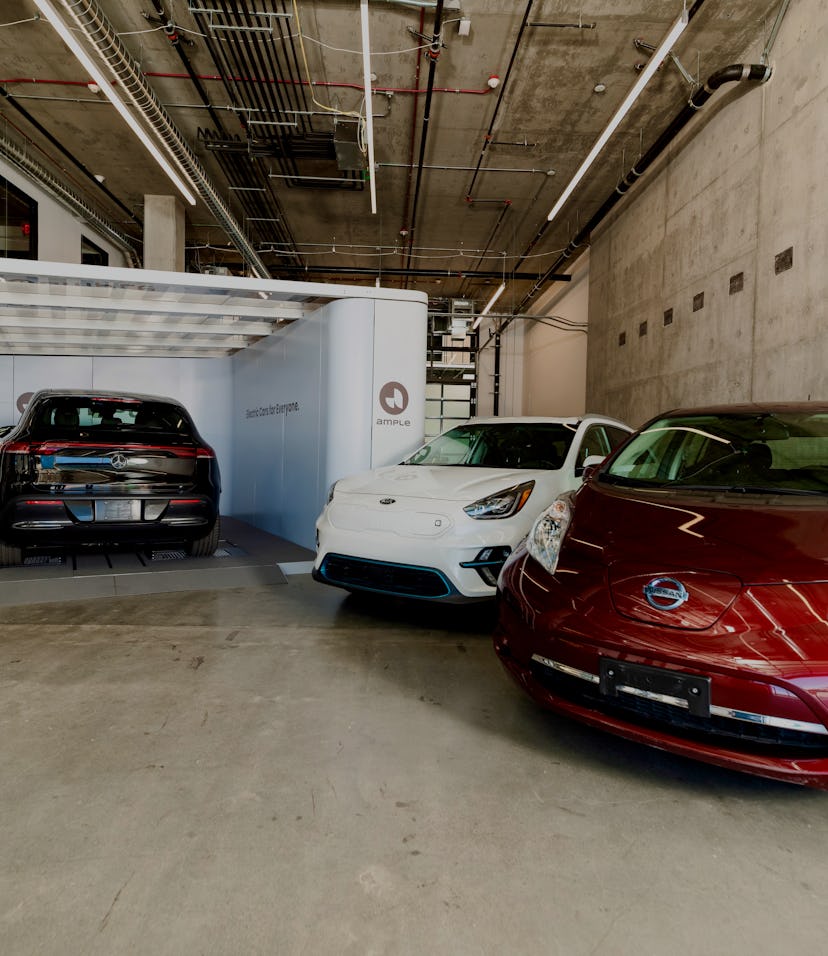Tech
Ample’s plan to make EVs viable for ride-sharing? Swappable batteries.
The company aims to make electric cars more viable for services like Uber and Lyft via a partnership with EV ride-share company Sally.

Even when using rapid chargers, electric vehicles take far longer to refill than combustion-engine ones do. That makes them a tough sell for businesses like ride-sharing services, and for consumers who don’t have the option to charge their cars at home. Californian company Ample believes it has the solution. Instead of recharging EVs, it wants to swap out batteries that are running out of juice for full ones, in under 10 minutes, and for less than it costs to refuel a gas guzzler.
To help it make this a reality, the company is partnering with Sally, an EV ride-sharing service that’s rolling out EV fleets of Uber and Lyft vehicles in Chicago, Los Angeles, San Francisco, and New York City (if you’ve seen a Tesla in Yellow Cab livery in the Big Apple in recent weeks, what you saw was likely one of Sally’s vehicles).
Long Island, long haul — Ample say’s its first “Swapping Station” in New York will open in Long Island City, but acknowledges it’ll need many more if it’s model is going to reach scale. Recharging electric vehicles remains challenging in New York City, where many people park on the street, or in parking lots that don’t necessarily have recharging facilities. An alternative that’s even faster than a Tesla SuperCharger would be very welcome indeed, and increase the number of New Yorkers who’d consider buying an EV significantly.
Through its new partnership, Ample hopes to do just that. Sally says it’s rolling out 100s of EVs in its launch cities, which gives Ample at least one, dependable fleet client in each.
Fully Automatic Luxury Charging-ism — Ample says it's gotten five OEMs interested in its technology, and it has ambitious plans of extending its services not just to private electric car owners or ride-sharing companies , but to other fleets, too, like those that rely on mid-sized trucks and delivery vehicles. It also has ambitions of using green energy to refill its batteries.
Looking at the supplied images, those OEMs include Tesla, Nissan, Mercedes-Benz, and Kia. But it’s unclear how on-board they are, or who the fifth is. Ample says it can’t reveal the OEMs due to NDAs, but confirms its five of them, and nine vehicles across them which it’ll support.
“Ample's battery is a drop-in replacement for the OEM battery and does not require any modification to the car (either hardware or software),” Khaled Hassounah, Ample’s CEO and founder told Input via email. “We are the first modular, battery-swapping EV network to serve multiple brands. Our modular batteries stack like Lego, so they can fit into any electric vehicle model.”
More efficient than regular charging — Ample says another advantage of its solution is that that its energy transfer from grid to vehicle is “about 95% efficient,” which is far less wasteful than the roughly 30 percent of energy lost to heat during high-speed cable charging.
Initally, Sally says its focusing on San Francisco because of how much EV infrastructure there is in the city (and because California intends to force ride-share services to go electric by 2030), and says it will use the lessons learned there to help Ample fine-tune its rollout elsewhere, from deciding where to place Swapping Stations to addressing concerns raised by actual Sally drivers’ experiences using Ample’s services.
Not totally new — Sally was founded in 2015, and already has a foothold in California. Ample, meanwhile, only announced itself in March of this year, but its founders say it spent “seven years of quiet research and development” getting to that point.
We hope that combined decade-plus of experience pays off, because not having to worry about battery degradation on top of being able to “fill up” in minutes would further reduce the cost of ownership of EVs... and ultimately it’s cutting the cost of EV ownership — or making iconic cars in electrified versions like Ford’s done — that’s most likely to get people buying them.